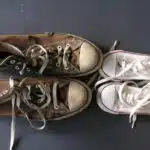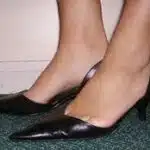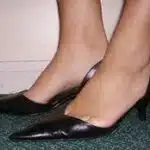Shoe racks are an essential accessory in any home. They help to keep your shoes organized and tidy, while also ensuring that they are easy to find when you need them. Building a shoe rack is a simple and cost-effective way to add extra storage space to your home.
In this article, we will provide you with step-by-step instructions on how to build a shoe rack from scratch. Whether you’re a DIY enthusiast or a beginner, our guide will help you create the perfect shoe rack for your needs. We’ll cover everything from selecting the right materials to measuring and cutting the wood, and assembling it all together. Follow our instructions carefully, and you’ll have a functional and stylish shoe rack in no time!
Assessing Your Shoe Storage Needs
Organizing your shoe collection can be like solving a puzzle, but it’s a challenge that is worth tackling. Just like how a puzzle requires patience and strategy, maximizing space for your shoes requires careful assessment of your storage needs. By incorporating design into the equation, you can create a shoe rack that not only serves its purpose but also adds to the aesthetic appeal of your room.
Assessing your shoe storage needs means taking an inventory of all the shoes you own and determining how many pairs you need to accommodate. This process allows you to determine the size and type of shoe rack that would work best for you. It’s important to consider any future growth in your collection as well.
Maximizing space is crucial when building a shoe rack. You want to ensure that there is enough space to store all your shoes while still making sure the rack doesn’t take up too much floor space in your room. The design should also complement the overall style of your home decor. With these considerations in mind, you’ll be on your way to building a functional and visually appealing shoe rack that will keep your shoes organized and easily accessible.
As you move forward with selecting the right materials for your shoe rack, keep in mind the importance of durability and stability. By using high-quality materials, you can ensure that this piece will last for years to come and continue serving its purpose efficiently.
Selecting The Right Materials
Choosing Materials for Your Shoe Rack
When it comes to building a shoe rack, selecting the right materials is crucial. You want to make sure that your shoe rack is sturdy and durable enough to hold all of your shoes without breaking or collapsing. One of the most popular materials for building a shoe rack is wood, which is not only strong but also aesthetically pleasing.
Cost Considerations
However, when choosing your wood, cost should be a consideration. Hardwoods such as oak and maple are beautiful and long-lasting but can be quite expensive. Softwoods such as pine or spruce are more affordable but may not last as long. It’s important to strike a balance between cost and durability when choosing the wood for your shoe rack.
Now that you understand the importance of selecting the right materials for your shoe rack, it’s time to consider cost and durability when making your selection. Once you have chosen the type of wood you will be using, the next step is measuring and marking the wood before cutting it into pieces for assembly.
Measuring And Marking The Wood
Accurate measurement and marking of the wood is essential to the success of your shoe rack project. You should use a measuring tape, a square, and a pencil for this task. It’s important to take into account the width of the boards that you will be using when measuring and marking the wood.
To ensure measuring accuracy, measure twice before marking your wood. Be sure to double check each measurement before moving on to the next step. If you’re not confident in your measurements, it’s better to remeasure than to make a mistake that will cost you time and materials.
When it comes to wood marking techniques, there are a few different options available. You can use a straight edge or square to mark straight lines, or you can use a compass or protractor for more complex angles. No matter which technique you choose, it’s important to make clear and accurate marks on the wood so that you can cut it correctly in the next step.
Now that you have accurately measured and marked your wood, it’s time to move on to cutting it to size. With your trusty saw in hand, follow these instructions carefully…
Cutting The Wood To Size
After measuring and marking the wood, the next step in building a shoe rack is cutting the wood to size. This is where you will need to utilize various cutting techniques to ensure that your wooden pieces are cut accurately and cleanly. It is important to note that safety precautions should be taken while using any power tools or sharp objects.
One of the most common cutting techniques used in woodworking is using a saw. A handsaw or circular saw can be used for this project, depending on personal preference and availability of tools. When using a saw, make sure to follow the manufacturer’s instructions carefully and always wear protective gear such as safety goggles and gloves. Another cutting technique that can be employed is using a jigsaw or band saw for more intricate cuts. These types of saws are especially useful when creating curves or angles in your wooden pieces.
When cutting the wood, it is important to take into consideration any potential flaws or knots in the wood grain. These areas may require extra attention when making cuts in order to avoid damaging your blade or creating an uneven edge. Additionally, taking time to properly measure and mark your cuts before beginning will help ensure that everything lines up correctly during assembly later on.
As you move forward with building your shoe rack, remember to always prioritize safety by taking necessary precautions when handling any tools or equipment. With proper cutting techniques and careful attention paid to detail, you’ll have all of your wooden pieces cut exactly how they need to be for a successful build. Next up: sanding and preparing the wood for assembly.
Sanding And Preparing The Wood
Sanding is a critical step in building any piece of furniture, including a shoe rack. Sanding wood is like polishing rough diamonds, giving it a smooth and refined texture that’s both visually appealing and functional. Before sanding, it’s essential to remove any dirt or debris using a damp cloth. Once the surface is clean, you can start sanding the wood.
Wood sanding techniques vary depending on the project and type of wood used. A general rule of thumb is to start with coarse-grit sandpaper (around 60-80 grit) to remove any rough patches or uneven surfaces. Then, gradually move up to finer grits (120-220 grit) until the surface becomes smooth to the touch. Remember that sandpaper has different grits, each suited for specific tasks. Choosing the right sandpaper grits ensures that you achieve a perfect finish without damaging the wood’s natural grain.
Sanding takes time and patience, but it’s worth it when you see your finished product come together seamlessly. Once you’ve sanded all your wooden pieces to perfection, you’re ready for the next step: assembling the shoe rack frame. But before that, make sure to clean off any sawdust on your work area as it can cause problems later on if left unattended.
Assembling The Shoe Rack Frame
To assemble the shoe rack frame, you will need a few tools. First, gather a drill, screws, wood glue, a saw, and sandpaper. Make sure all your tools are in good working condition before starting the project. Take safety measures such as wearing gloves and safety glasses to avoid any accidents.
Preparing the workspace is essential before beginning the assembly process. Find a flat surface that can hold all your materials and allow you to move around freely. Ensure there’s enough light in the area and ventilation if you’re working with wood glue or paint. Clear out any clutter or debris that may cause tripping hazards during assembly.
Once you have all your tools set up and workspace prepared, it’s time to start assembling the frame of your shoe rack. Follow the manufacturer’s instructions carefully to ensure proper assembly of each piece. Remember to double-check measurements before cutting any pieces of wood and sand them down for a smoother finish. With patience and attention to detail, your shoe rack frame will be ready for adding shelves and dividers in no time.
Transition: Now that we have successfully assembled the shoe rack frame, it’s time to move on to adding shelves and dividers for optimal organization of shoes.
Adding Shelves And Dividers
A shoe rack is not only a practical solution for organizing shoes, but it can also save space in your home. Adding shelves and dividers to the shoe rack can help maximize the shoe organization while providing space-saving solutions. You can customize your shelf and divider sizes according to the size of your shoes.
To add shelves, first, determine where you want them to be placed. Measure and mark out where the brackets will go on each side of the shoe rack. Install the brackets by drilling pilot holes into the marked areas and screwing them in place. Then, cut your desired shelf size from a sturdy material such as wood or particleboard. Lastly, place the shelf onto the brackets and secure it in place with screws or adhesive.
Dividers can be added to separate different types of shoes or create individual compartments for each pair of shoes. To make dividers, measure and cut pieces of wood or particleboard to fit between each shelf. Make sure they fit snugly in place before securing them with screws or adhesive. You can also use wire mesh or fabric as dividers if you prefer a more flexible option.
With these easy steps, you’ll have a customized shoe rack that maximizes shoe organization while saving valuable space in your home. Next up is attaching the back panel to complete this DIY project!
Attaching The Back Panel
In order to attach a back panel to a shoe rack, it is important to first accurately measure the space where the panel will go. After measuring, use a saw to cut the panel to the correct size. Once the panel is cut, attach it to the frame of the shoe rack with a hammer and nails. It is important to ensure the nails are properly aligned and the panel is securely fastened. For further stability, it is recommended to use wood glue and clamps to further secure the panel in place. Once the glue has dried, the back panel is securely attached and the shoe rack is ready for use.
Measuring For The Panel
When building a shoe rack, it is essential to measure accurately for the back panel. This ensures that the panel fits perfectly and provides adequate support to the shoes. Before taking any measurements, ensure that all other parts of the shoe rack are complete, including the shelves and sides.
To measure for the shoe rack back panel, take accurate measurements of both the width and height of the entire unit. Next, subtract any measurement of shelves or sides from these dimensions to get an accurate measurement for the back panel. It is important to double-check all measurements before cutting any wood panels.
It is advisable to mark all cut lines on the wood panel before making any cuts. This will help reduce errors and ensure that cuts are made at precise locations. With accurate measurements and careful marking, it is possible to build a sturdy shoe rack with an excellent fitting back panel.
Cutting The Panel
Now that accurate measurements have been taken for the shoe rack back panel, it is time to cut the panel. It is important to note that the thickness of the wood panel should be considered when making cuts. The panel thickness affects the angle of the saw blade and can result in inaccurate cuts if not accounted for.
To begin cutting, it is advisable to start with smaller cuts before progressing to larger ones. This allows for better control of the saw blade and reduces the risk of errors. Additionally, using a circular saw or jigsaw is recommended as they provide more precision compared to other cutting tools.
When making angled cuts, it is essential to double-check all measurements and angles before cutting. Any errors made during this stage may render the shoe rack unusable. To reduce errors, marking out all cut lines on the wood panel beforehand is crucial. By following these steps, a perfect fitting back panel can be achieved with ease and efficiency.
Attaching The Panel
With the back panel successfully cut to size, the next step is to attach it to the shoe rack. Using screws is the most reliable method of attaching the panel securely and ensuring longevity. Before starting, ensure that all other parts of the shoe rack are well-assembled and stable.
To attach the back panel, place it against the rear of the shoe rack and use clamps to hold it in place. Take care not to damage any part of the rack during this process. Once in position, drill pilot holes for each screw along the edges of both sides of the panel. This will prevent any splitting or cracking when securing it with screws.
Once all pilot holes have been drilled, remove the clamps and begin attaching the panel using screws. Start at one corner and work your way around, ensuring that each screw is firmly tightened. Once complete, check that all edges are flush with no gaps or protrusions. With this done, you can now add any finishing touches such as sanding or painting as desired.
Finishing The Shoe Rack
With the back panel now securely attached, the shoe rack is taking shape. The next step is to apply varnish to protect and enhance the natural beauty of the wood. This can be done using a foam brush, following the manufacturer’s instructions for drying time and number of coats.
Once the varnish has dried, it’s time to add accessories to the shoe rack. A simple yet effective addition is hooks or knobs on either side of the rack for hanging bags or hats. Another option is a cushioned seat on top of the rack, providing a comfortable place to sit while putting on shoes.
When adding accessories, it’s important to keep in mind the overall aesthetic of the shoe rack. Choose items that complement the style and color of the wood, creating a cohesive look. With these final touches complete, your shoe rack will not only be functional but also a stylish addition to your home.
As you consider painting or staining the wood, keep in mind that these options may require additional steps such as sanding or priming before application. Take time to research and choose a technique that works best for your desired outcome. With your shoe rack complete, take pride in your DIY skills and enjoy having an organized space for all your footwear needs.
Painting Or Staining The Wood
When it comes to building a shoe rack, painting or staining the wood is an essential step. Not only does it add an aesthetic appeal to the finished product, but it also provides protection against moisture and wear and tear. Choosing colors and applying finishes can be daunting, but with some guidance, you can achieve beautiful results.
Before deciding on a color scheme, consider the style of your home and the existing furniture in the room where you plan to place the shoe rack. Neutral colors such as white, gray, or beige are versatile options that match almost any decor. For a bold statement piece, choose bright colors like red or blue that complement your room’s accent colors. Once you have chosen your color palette, select a finish type based on your wood choice. Satin or gloss finishes provide durability for high-traffic areas whereas matte finishes offer a more natural look.
When applying finishes, ensure that the wood surface is clean and dry before starting. Use a brush or roller to apply the paint or stain evenly across all surfaces of the shoe rack. Apply multiple coats if necessary to achieve desired opacity and coverage. Allow sufficient time for drying between coats before sanding with fine-grit sandpaper for added smoothness. After completing this step, move on to installing hooks or hangers for added convenience in organizing shoes.
Table:
| Step | Procedure | Tools Needed |
|---|---|---|
| 1 | Choose color scheme | Color swatches |
| 2 | Select finish type | Paint brushes/rollers |
| 3 | Clean & dry wood surface | Sandpaper (fine grit) |
| 4 | Apply first coat of paint/stain evenly across all surfaces | Paint/stain container |
| 5 | Allow time for drying between coats if necessary | Paint/stain brush/roller |
| 6 | Sand with fine-grit sandpaper after each coat dries | Drop cloth |
| 7 | Apply second coat if needed | Masking tape |
Now that you have painted or stained your shoe rack, it is time to move on to the next step of installing hooks or hangers. This will allow you to maximize storage space and create a more organized area for your shoes. Installing hooks or hangers is a simple process that can be done with basic tools such as screws and a drill. In the next section, we will provide an overview of the steps required to install hooks or hangers on your shoe rack.
Installing Hooks Or Hangers
After painting or staining the wood, it’s time to move on to the next step of building your shoe rack – installing hooks or hangers. This is an essential part of the process as it will allow you to maximize space and keep your shoes organized in a neat and tidy manner. There are different hook options that you can choose from depending on your needs and preferences.
One option is using S-hooks which can be easily attached to the wooden slats of your shoe rack. This type of hook will allow you to hang several pairs of shoes securely without taking up too much space. Another option is using over-the-door hooks which can be hung on the back of a door or even a closet rod. If you have limited floor space, this is an excellent solution for keeping your shoes off the ground.
If you want a more permanent solution, consider installing wall-mounted hooks or hangers. This option will require some drilling and mounting hardware, but it offers a sturdy and secure way to store your shoes. You can also choose from different materials such as metal or plastic, depending on the style and durability you’re looking for.
Maximizing space and keeping your shoes organized doesn’t have to be complicated. By choosing the right hook options for your shoe rack, you can create a functional storage solution that fits perfectly in your home. In the next section, we’ll talk about adding decorative touches to give your shoe rack a personal touch while still being practical and functional.
Adding Decorative Touches
Once you have built your shoe rack, you may want to add some embellishments to personalize its design. This is where you can let your creativity shine and make your shoe rack truly unique. Here are a few ideas to get you started:
Paint – A fresh coat of paint can do wonders for any piece of furniture. Consider using a bold color or pattern to make your shoe rack stand out. You could also use stencils or tape to create a geometric design.
Stickers – If painting isn’t your thing, stickers can be an easy way to add some personality to your shoe rack. Look for fun designs that match the style of your home or reflect your interests.
Knobs and Hooks – Adding knobs or hooks can not only be decorative but also functional. They provide extra storage space for hats, scarves, or keys while also adding visual interest.
Adding embellishments is a great way to make your shoe rack more than just a functional piece of furniture but also a statement piece in your home decor. Don’t be afraid to experiment with different colors, patterns, and textures until you find the perfect combination that reflects your personal style.
As you finish up adding those finishing touches, it’s important not to neglect the maintenance of your new shoe rack. In the next section, we’ll discuss some tips for keeping it looking great for years to come.
Tips For Maintaining Your Shoe Rack
Organizing shoes on a shoe rack can be a daunting task, but with a few simple tips it can be made much easier. Start by grouping shoes together in categories such as formal, casual, or athletic. This will help to keep the rack looking neat and organized. In addition, it is important to regularly clean the shoes before putting them on the rack to prevent dirt and debris from accumulating over time. Lastly, it is important to store shoes away from direct sunlight as this can cause fading and cracking of the material.
Organizing Shoes
When it comes to maintaining a shoe rack, one of the most important aspects is organizing shoes. Maximizing space in a shoe rack can be a challenge, especially if you have a large collection of shoes. However, with some creative shoe storage solutions, you can keep your shoes organized and easily accessible.
One solution for organizing shoes is to use hanging organizers. These organizers can be hung from the back of a door or on the wall and provide multiple pockets for storing shoes. This not only maximizes space but also keeps your shoes off the floor and out of the way.
Another option for creative shoe storage is to use cubbies or shelves. This allows each pair of shoes to have its own designated spot, making it easy to find what you’re looking for. You can also stack the cubbies or shelves vertically to save space and create a visually appealing display.
By utilizing these creative shoe storage solutions, you can maintain an organized shoe rack that maximizes space while keeping your footwear easily accessible. Whether you’re looking to declutter your closet or simply want to showcase your favorite pairs of shoes, implementing these tips will help you achieve a well-organized and functional shoe rack.
Cleaning Shoes
Now that we’ve discussed some creative storage solutions for shoes, it’s important to address the topic of shoe care. Proper cleaning and maintenance of your shoes is crucial in keeping them looking their best and extending their lifespan. Neglecting to care for your shoes can lead to discoloration, deterioration, and even irreversible damage.
To begin with, it’s essential to have the right cleaning supplies on hand. A soft-bristled brush, a mild detergent, and a clean cloth are all you need to give your shoes a thorough cleaning. Be sure to remove any dirt or debris from the surface of the shoe before applying any cleaning solution.
When it comes to storage solutions, it’s important to consider how you store your shoes after they’ve been cleaned. One option is to use shoe trees or inserts which help maintain the shape of the shoe while also absorbing moisture and odor. Another option is to store your shoes in breathable bags or boxes that protect them from dust and light.
By incorporating these shoe care tips into your routine and utilizing proper storage solutions, you’ll be able to maintain the appearance and longevity of your footwear collection. With just a little bit of effort, you can ensure that your favorite pairs of shoes remain in great condition for years to come.
Alternative Shoe Rack Designs To Consider
As the saying goes, “variety is the spice of life.” When it comes to shoe racks, there are plenty of alternative designs to consider. Space-saving designs are a popular choice for those with limited room. Wall-mounted shoe racks and over-the-door organizers are perfect examples of this. These options allow you to keep your shoes off the floor and out of the way while still being easily accessible.
Eco-friendly options are also becoming increasingly popular. Instead of using materials like plastic or metal, consider using bamboo or reclaimed wood for a more sustainable option. Not only does this reduce waste, but it also adds a unique and natural touch to your home decor. Plus, you can feel good about making a positive impact on the environment.
Overall, there are endless possibilities when it comes to designing your own shoe rack. Whether you opt for space-saving designs or eco-friendly materials, the most important thing is choosing what works best for you and your lifestyle. In the next section, we will explore some common issues that may arise when building your own shoe rack and how to troubleshoot them effectively.
Troubleshooting Common Shoe Rack Issues
Solving construction challenges is a natural part of any DIY project, and building a shoe rack is no exception. One common issue that might arise when constructing a shoe rack is the instability of the structure. This can be caused by uneven legs or improper placement of shelves. To avoid this problem, make sure to measure and level each leg before attaching any shelves. If necessary, use shims to adjust for any unevenness. Additionally, consider adding cross braces or brackets for added stability.
Another challenge when building a shoe rack is maximizing storage capacity while maintaining organization and accessibility. A simple solution to this issue is to add adjustable shelving or cubbies that can be customized to fit different sized shoes. To further optimize space, consider using vertical space by adding additional levels or hanging organizers on the sides of the rack. Another creative option is to build a pull-out drawer at the bottom of the rack for additional storage.
Overall, it’s important to approach shoe rack construction with both practicality and creativity in mind. While there may be some challenges along the way, they can often lead to unique solutions that enhance both the functionality and aesthetics of your finished product. With careful planning and attention to detail, you can create a durable and efficient shoe rack that meets all your storage needs without sacrificing style or convenience.
Conclusion
Building a shoe rack can seem daunting at first, but with the right materials, tools, and guidance, it can be a rewarding DIY project. Just like organizing shoes in a closet, building a shoe rack requires assessing your storage needs and selecting the appropriate design. With careful measuring, cutting, and sanding of the wood, you can create a sturdy and functional shoe rack that adds both style and practicality to your living space.
When maintaining your shoe rack, it’s important to keep in mind its purpose as well as its aesthetic value. Regular cleaning and upkeep can help prevent wear and tear on the wood and ensure that your shoes are stored properly. If you encounter any issues during the building process or after installation, there are various troubleshooting techniques that you can implement to resolve them.
Building a shoe rack is like laying down new roots for your footwear collection. With patience, care, and attention to detail, you can create a beautiful addition to your home while also keeping your shoes organized and easily accessible. So roll up your sleeves and get ready to build – before you know it, you’ll have a functional piece of furniture that reflects both your personality and your knack for DIY home improvement.
Image Credits
- “Shoe Rack?” by Maura McDonnell (featured)
























![How To Repair Rotted Wood 24 Texture : Altario Buick Estate Wagon : Rotting Faux Wood Paneling [1 of 2]](https://green-life.blog/wp-content/uploads/2023/05/z1CersK-gCjq-150x150.jpg.webp)




